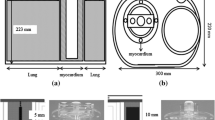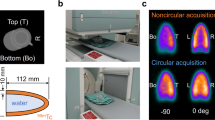Abstract
Background
This investigation used image data generated by a physical phantom over a wide range of count statistics to evaluate the effectiveness of several of the newer commercially available SPECT reconstruction iterative algorithms (IRR) in improving perfusion defect contrast and spatial resolution, while controlling image noise.
Methods
A cardiac phantom was imaged using four different gamma cameras over a wide range of counts statistics (from 6 to 0.8 Mcounts). Images were reconstructed with FBP, OSEM, and the IRR available on site. IRR were applied without corrections (IRR NC), with attenuation correction (IRR AC), scatter correction (IRR SC), and attenuation + scatter corrections (IRR SCAC). Four image performance indices related to spatial resolution, contrast, and image noise were analyzed.
Results
IRR NC always determined significant improvements in all indices in comparison to FBP or OSEM. Improvements were emphasized with IRR SC and IRR SCAC. Count reduction from 6 to 1.5 Mcounts did not impair the performances of any of the considered indices.
Conclusions
This is the first study comparing the relative performance of different, commercially available, IRR software, over a wide range of count statistics; the additional effect of scatter and attenuation corrections, alone or in combination, was also evaluated. Our results confirm that IRR algorithms produce substantial benefits with respect to conventional FBP or OSEM reconstruction methods, as assessed through different figures of merit, in particular when SC and/or SCAC are also included.









Similar content being viewed by others
References
Marcassa C, Campini R, Zoccarato O, Calza P. Wide beam reconstruction for half-dose or half-time gated SPECT acquisitions: Optimization of resources and reduction in radiation exposure. Eur J Nucl Med Mol Imaging 2011;38:499-508.
Leva L, Brambilla M, Matheoud R, Vigna L, Marino P, Inglese E. The relationship between quantitative perfusion and functional results and acquisition time with reduced administered activity for 99 mTc tetrofosmin myocardial gated-SPECT. Clin Nucl Med 2012;37:e162-9.
Enevoldsen LH, Menashi CAK, Andersen UB, Jensen LT, Henriksen OM. Effects of acquisition time and reconstruction algorithm on image quality, quantitative parameters, and clinical interpretation of myocardial perfusion imaging. J Nucl Cardiol 2013. doi:10.1007/s12350-013-9775-2.
Wells RG, Soueidan K, Timmins R. Ruddy TD Comparison of attenuation, dual-energy-window, and model-based scatter correction of low-count SPECT to (82)Rb PET/CT quantified myocardial perfusion scores. J Nucl Cardiol 2013;20:785-96.
Venero CV, Heller GV, Bateman TM, McGhie AI, Ahlberg AW, Katten D, et al. A multicenter evaluation of a new post-processing method with depth-dependent collimator resolution applied to full-time and half-time acquisitions without and with simultaneously acquired attenuation correction. J Nucl Cardiol 2009;16:714-25.
De Lorenzo A, Fonseca LM, Landesmann MC, Lima RS. Comparison between short-acquisition myocardial perfusion SPECT reconstructed with a new algorithm and conventional acquisition with filtered backprojection processing. Nucl Med Commun 2010;31:552-7.
Vija AH, Hawman EG, Engdahl JC. Analysis of a SPECT OSEM reconstruction method with 3D beam modeling and optional attenuation correction: Phantom studies. Nucl Sci Symp Conf Rec 2003;4:2662-6.
DePuey EG, Bommireddipally S, Clark J, Thompson L, Srour Y. Wide beam reconstruction “quarter-time” gated myocardial perfusion SPECT functional imaging: A comparison to “full-time” ordered subset expectation maximization. J Nucl Cardiol 2009;16:736-52.
Borges-Neto S, Pagnanelli RA, Shaw LK, Honeycutt E, Shwartz SC, Adams GL, et al. Clinical results of a novel wide beam reconstruction method for shortening scan time of Tc-99 m cardiac SPECT perfusion studies. J Nucl Cardiol 2007;14:555-65.
Modi BN, Brown JLE, Kumar G, Driver RM, Kelion AD, Peters AM, et al. A qualitative and quantitative assessment of the impact of three processing algorithms with halving of study count statistics in myocardial perfusion imaging: Filtered backprojection, maximal likelihood expectation maximization and ordered subset expectation maximization with resolution recovery. J Nucl Cardiol 2012;19:945-57.
Ali I, Ruddy TD, Almgrahi A, Anstett FG, Wells RG. Half-time SPECT myocardial perfusion imaging with attenuation correction. J Nucl Med 2009;50:554-62.
Hughes T, Shcherbinin S, Celler A. A multi-center phantom study comparing image resolution from three state-of-the-art SPECT-CT systems. J Nucl Cardiol 2009;16:914-26.
Knoll P, Kotalova D, Köchle G, Kuzelka I, Minear G, Mirzaei S, et al. Comparison of advanced iterative reconstruction methods for SPECT/CT. Z Med Phys 2012;22:58-69.
Higley B, Smith FW, Smith T, Gemmell HG, Das Gupta P, Gvozdanovic DV, et al. Technetium-99m-1,2-bis[bis(2-ethoxyethyl) phosphino]ethane: Human biodistribution, dosimetry and safety of a new myocardial perfusion imaging agent. J Nucl Med 1993;34:30-8.
Rasband WS. ImageJ. U. S. National Institutes of Health, Bethesda, MD, USA. 1997-2012. http://imagej.nih.gov/ij/. Accessed 14 Aug 2013.
DePuey EG. Advances in SPECT camera software and hardware: Currently available and new on the horizon. J Nucl Cardiol 2012;19:551-81.
Slomka PJ, Dey D, Duvall WL, Henzlova MJ, Berman DS, Germano G. Advances in nuclear cardiac instrumentation with a view towards reduced radiation exposure. Curr Cardiol Rep 2012;14:208-16.
Disclosures
None.
Author information
Authors and Affiliations
Corresponding author
Rights and permissions
About this article
Cite this article
Zoccarato, O., Scabbio, C., De Ponti, E. et al. Comparative analysis of iterative reconstruction algorithms with resolution recovery for cardiac SPECT studies. A multi-center phantom study. J. Nucl. Cardiol. 21, 135–148 (2014). https://doi.org/10.1007/s12350-013-9821-0
Received:
Accepted:
Published:
Issue Date:
DOI: https://doi.org/10.1007/s12350-013-9821-0




